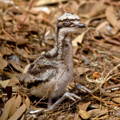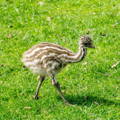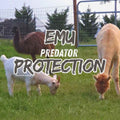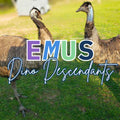
Role of the Yolk Sac in Emu Embryo Development
Learn how the yolk sac supports emu chicks during development, providing essential nutrients for growth inside the egg. Discover its crucial role in healthy emu hatching eggs.
The remaining yolk sac is absorbed into the belly of the emu chick before hatching to provide nourishment the first days of life.
Subscribe
To join our mailing list and never miss an update!
Emus, as large flightless birds native to Australia, undergo a fascinating embryonic development process inside the egg. Central to this development is the yolk sac, a structure that plays a crucial role in the survival and growth of the developing embryo. Serving as both a source of nourishment and support for various physiological functions, the yolk sac is indispensable to the embryo’s journey from fertilization to hatching.

Early Embryo Development and the Formation of the Yolk Sac
The development of an emu embryo begins shortly after fertilization, with the formation of a small cluster of cells known as the blastoderm. This cluster is located on the surface of the egg’s yolk, a nutrient-rich mass that will provide the energy and building blocks for the embryo’s growth. At this early stage, the yolk sac starts to form, encompassing the yolk and creating a specialized membrane that will serve as the main conduit for nutrient absorption.
The yolk sac membrane, which surrounds the yolk, becomes intricately linked to the embryo through a network of blood vessels. This vascular system is vital, as it allows the embryo to absorb proteins, fats, vitamins, and minerals from the yolk, facilitating the growth and development of essential organs, tissues, and body systems. Without this connection, the embryo would lack the resources needed for its early developmental stages.
Nutritional Role of the Yolk Sac
One of the primary functions of the yolk sac is to supply the developing embryo with a steady stream of nutrients. The yolk contains high concentrations of proteins and lipids (fats) necessary for the construction of the embryo’s cells and tissues. Proteins, for instance, are used in the formation of muscles, bones, and other structures, while fats serve as a dense energy source required for the rapid growth occurring during the embryonic period.
The yolk sac also plays an essential role in providing vitamins and minerals that support metabolic processes and aid in the development of physiological systems. Calcium from the yolk, for example, is crucial for proper bone formation, while vitamins like A, D, and E contribute to cell growth, immunity, and overall health.
Blood Cell Formation and Immune Support
While the yolk sac is commonly known for its role in nutrient supply, it has another critical function—supporting early blood cell formation. During the first few weeks of development, the yolk sac produces red blood cells, which are essential for transporting oxygen throughout the embryo. These blood cells are later supplemented by the embryo’s own blood-forming organs, but the yolk sac’s contribution is crucial during this initial phase.
Additionally, the yolk sac contains immune factors that help protect the embryo from potential infections within the egg. This early immune support is vital as the embryo grows and becomes more complex, ensuring it remains healthy throughout its development.
Yolk Sac Absorption and the Final Stages of Development
The process of yolk absorption is gradual, but critical. As the emu embryo matures and approaches hatching, the yolk sac continues to provide nutrients until it is absorbed into the chick’s abdomen. When the chick hatches, it will use this sustenance to survive the first few days of life outside the egg. This process ensures that the emu chick can survive without immediate access to external food sources, allowing it time to adjust to its new environment before it needs to feed.
Trending Articles
Potential Complications: When the Yolk Sac Is Not Fully Absorbed
Despite the importance of yolk absorption, complications can arise when this process is incomplete. If the yolk sac is not fully absorbed before hatching, the chick may face several risks:
1. Nutritional Deficiency: Without fully absorbing the yolk, the chick may not receive the complete range of nutrients required for optimal growth. This can lead to weakness, poor development, or failure to thrive. The remaining yolk would have served as a critical energy reserve during the chick’s early days outside the egg.
2. Infection Risk: The unabsorbed yolk sac can be prone to bacterial infection once exposed to the outside environment. The umbilical opening, if not closed properly, can serve as a point of entry for pathogens, leading to serious infections like septicemia, which can be fatal if untreated.
3. Delayed Growth: A chick that hatches with a partially absorbed yolk sac may show signs of delayed development. The chick might struggle to walk or feed effectively, making it vulnerable to further health issues.

These complications can sometimes be managed with proper care, such as isolating the chick to prevent infection and ensuring it is kept warm and protected while it heals. However, prevention of such complications is ideal, ensuring the yolk sac is fully absorbed before the chick hatches. This is one of the reasons it is so important not to rush an emu chick’s hatching process by intervening to help it out of the egg.
Trending Products
Copyright©2024 All rights reserved. We love to have you share our article as long as you include a direct link to this page. This article or any portion thereof , including all images, may not be reproduced or used in any manner whatsoever without the express written permission of Gypsy Shoals Farm.






